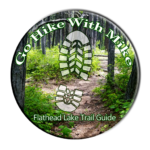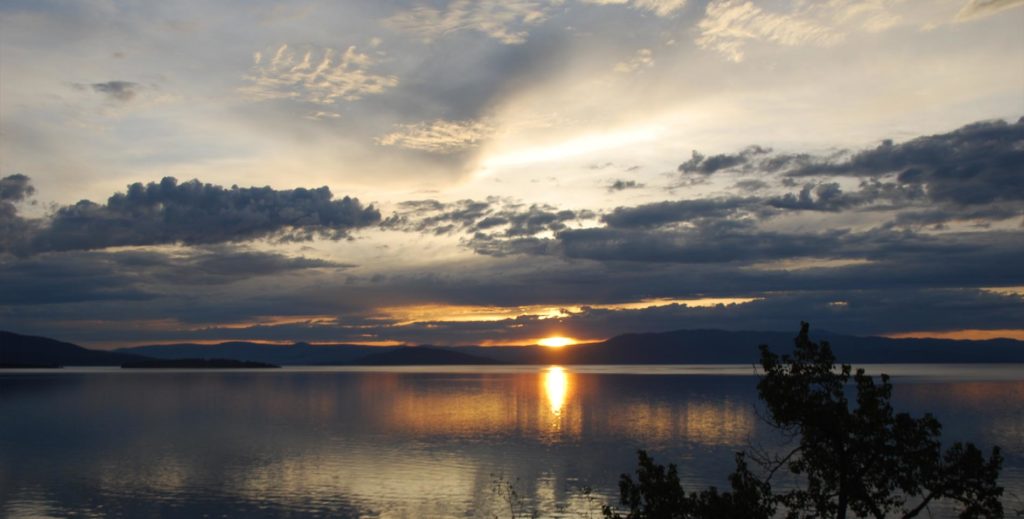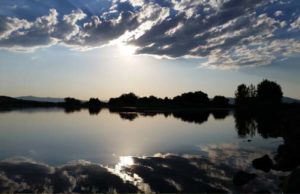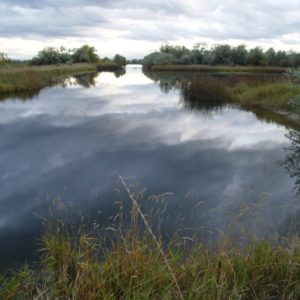Come and experience Glacier’s pristine forests, alpine meadows, rugged mountains, and spectacular lakes. With over 700 miles of trails, Glacier is a hiker’s paradise for adventurous visitors seeking wilderness and solitude. Relive the days of old through historic chalets, lodges, transportation, and stories of Native Americans. Explore Glacier National Park and discover what awaits you.
Glacier National Park
In 1910, Congress established Glacier National Park in Montana. Conservationist George Bird Grinnell played a key role in the creation of this park in order to preserve the land’s natural beauty. Indians have always revered this region. The Blackfeet, Salish, and Kootenai Indians, who have lived in the area for hundreds of years, consider it a sacred place.
 Glacier National Park is named for the glaciers that produced its landscape. A glacier is a moving mass of snow and ice. It forms when more snow falls each winter than melts in the summer. The snow accumulates and presses the layers below it into ice. The bottom layer of ice becomes flexible and therefore allows the glacier to move. As it moves, a glacier picks up rock and gravel. With this mixture of debris, it scours and sculptures the land it moves across. This is how, over thousands of years, Glacier National Park got all its valleys, sharp mountain peaks, and lakes. There are more than 50 glaciers in the park today, though they are smaller than the huge ones that existed 20,000 years ago.
Glacier National Park is named for the glaciers that produced its landscape. A glacier is a moving mass of snow and ice. It forms when more snow falls each winter than melts in the summer. The snow accumulates and presses the layers below it into ice. The bottom layer of ice becomes flexible and therefore allows the glacier to move. As it moves, a glacier picks up rock and gravel. With this mixture of debris, it scours and sculptures the land it moves across. This is how, over thousands of years, Glacier National Park got all its valleys, sharp mountain peaks, and lakes. There are more than 50 glaciers in the park today, though they are smaller than the huge ones that existed 20,000 years ago.
In addition to its glaciers, mountains, and valleys, Glacier National Park covers approximately 1.4 million acres and includes 200 lakes and streams. The park is also home to many different types of wildlife, including black and grizzly bear, moose, golden and bald eagle, bighorn sheep, mountain goat, and whitetail and mule deer.
Glacier National Park is a stunningly beautiful ice-carved terrain of serrated ridges, jutting peaks, dramatic hanging valleys, 50 glaciers, more than 200 lakes, waterfalls and thick forests covering some 1.2-million acres. Deer are among the most commonly spotted wildlife but elk, moose, mountain goats, bighorn sheep, wolves, grizzly and black bears roam its wild vastness and are often seen by visitors.
Goat Lick overlook, for example, is a natural salt lick on cliffs overlooking the southern border of the park. From a viewing platform just off US Highway 2 east of Essex you are sure to see mountain goats or other animals at any time of day enjoying the lick.
Wild flowers, too, are abundant and put on a lengthy show of color as they follow spring up the mountains all summer long.
 The park is unique among US parks in its relationship with the Waterton Lakes National Park in Alberta, Canada. The two parks meet at the border shared by the two countries. Though administered by separate countries, the parks are cooperatively managed in recognition that wild plants and animals ignore political boundaries and claim the natural and cultural resources on both sides of the border. In 1932, the parks were designated the first International Peace Park in recognition of the bonds of peace and friendship between the two nations. The two parks jointly share the name The Waterton-Glacier International Peace Park. Then, in 1995, The Waterton-Glacier International Peace Park was designated for inclusion as a World Heritage Site.
The park is unique among US parks in its relationship with the Waterton Lakes National Park in Alberta, Canada. The two parks meet at the border shared by the two countries. Though administered by separate countries, the parks are cooperatively managed in recognition that wild plants and animals ignore political boundaries and claim the natural and cultural resources on both sides of the border. In 1932, the parks were designated the first International Peace Park in recognition of the bonds of peace and friendship between the two nations. The two parks jointly share the name The Waterton-Glacier International Peace Park. Then, in 1995, The Waterton-Glacier International Peace Park was designated for inclusion as a World Heritage Site.
Visitor Centers
Glacier National Park is served by three Visitor Centers; Apgar, Logan Pass and St. Mary’s. Ranger-guided-naturalist activities are available throughout the park from mid-June through September. Call 406-888-5441 for details. You might like to enquire about having lunch on a glacier! The park has more than 700 miles of trails ranging from day hikes to extended treks. Trailheads for popular day hikes can be found near the visitors’ centers
Going-to-the-Sun Road
The famed 52-mile Going-to-the-Sun Road climbs 3,000 feet to provide spectacular views across the Continental Divide from June to October. It is closed the rest of the year due to heavy snows. Glacier Park Inc. operates a daily shuttle service along this road, from July 1 to Labor Day Weekend in September. The shuttle operates between Rising Sun Motor Inn and Lake McDonald Lodge, a useful service for those who have oversized rigs not allowed on the road, and others who would rather not drive the narrow mountain roads themselves.
History
Earlier this century, the Great Northern Railway built chalets to market Glacier National Park as the “Switzerland of America”. Although many no longer exist, Granite Park Chalet and Sperry Chalet are open to the public. Be warned that the former has no running water. The most popular route to Granite Park Chalet is a 7-mile hike along the Highline Trail from Logan Pass. Glacier Park Lodge, and Many Glacier Hotel also accommodate guests.
Glacier National Park, A Historical Overview
Before the Park
 Recent archaeological surveys have found evidence of human use dating back over 10,000 years. These people may have been the ancestors of tribes that live in the area today. By the time the first European explorers came to this region, several different tribes inhabited the area. The Blackfeet Indians controlled the vast prairies east of the mountains. The Salish and Kootenai Indians lived and hunted in the western valleys. They also traveled east of the mountains to hunt buffalo.
Recent archaeological surveys have found evidence of human use dating back over 10,000 years. These people may have been the ancestors of tribes that live in the area today. By the time the first European explorers came to this region, several different tribes inhabited the area. The Blackfeet Indians controlled the vast prairies east of the mountains. The Salish and Kootenai Indians lived and hunted in the western valleys. They also traveled east of the mountains to hunt buffalo.
In the early 1800’s, French, English, and Spanish trappers came in search of beaver. In 1806, the Lewis and Clark Expedition came within 50 miles of the area that is now the park.
As the number of people moving west steadily increased, the Blackfeet, Salish, and Kootenai were forced onto reservations. The Blackfeet Reservation adjoins the east side of the park. The Salish and Kootenai reservation is southwest of Glacier. This entire area holds great spiritual importance to the Blackfeet, Salish, and Kootenai people.
The railroad over Marias Pass was completed in 1891. The completion of the Great Northern Railway allowed more people to enter the area. Homesteaders settled in the valleys west of Marias Pass and soon small towns developed.
Under pressure from miners, the mountains east of the Continental Divide were acquired in 1895 from the Blackfeet. Miners came searching for copper and gold. They hoped to strike it rich, but no large copper or gold deposits were ever located. Although the mining boom lasted only a few years, abandoned mine shafts are still found in several places in the park.
Establishing the Park
Around the turn of the century, people started to look at the land differently. Rather than just seeing the minerals they could mine or land to settle on, they started to recognize the value of its spectacular scenic beauty. Facilities for tourists started to spring up. In the late 1890’s, visitors arriving at Belton (now called West Glacier) could get off the train, take a stagecoach ride a few miles to Lake McDonald, and then board a boat for an eight mile trip to the Snyder Hotel. No roads existed in the mountains, but the lakes allowed boat travel into the wilderness.
Soon people, like George Bird Grinnell, pushed for the creation of a national park. Grinnell was an early explorer to this part of Montana and spent many years working to get the park established. The area was made a Forest Preserve in 1900, but was open to mining and homesteading. Grinnell and others sought the added protection a national park would provide. Grinnell saw his efforts rewarded in 1910 when President Taft signed the bill establishing Glacier as the country’s 10th national park.
After the creation of the park, the growing staff of park rangers needed housing and offices to help protect the new park. The increasing number of park visitors made the need for roads, trails, and hotels urgent. The Great Northern Railway built a series of hotels and small backcountry lodges, called chalets, throughout the park. A typical visit to Glacier involved a train ride to the park, followed by a multi-day journey on horseback. Each day after a long ride in the mountains, guests would stay at a different hotel or chalet. The lack of roads meant that, to see the interior of the park, visitors had to hike or ride a horse. Eventually, the demand for a road across the mountains led to the building of the Going-to-the-Sun Road.
A Heritage for the Future
 The construction of the Going-to-the-Sun Road was a huge undertaking. Even today, visitors to the park marvel at how such a road could have been built. The final section of the Going-to-the-Sun Road, over Logan Pass, was completed in 1932 after 11 years of work. The road is considered an engineering feat and is a National Historic Landmark. It is one of the most scenic roads in North America. The construction of the road forever changed the way visitors would experience Glacier National Park. Future visitors would drive over sections of the park that previously had taken days of horseback riding to see.
The construction of the Going-to-the-Sun Road was a huge undertaking. Even today, visitors to the park marvel at how such a road could have been built. The final section of the Going-to-the-Sun Road, over Logan Pass, was completed in 1932 after 11 years of work. The road is considered an engineering feat and is a National Historic Landmark. It is one of the most scenic roads in North America. The construction of the road forever changed the way visitors would experience Glacier National Park. Future visitors would drive over sections of the park that previously had taken days of horseback riding to see.
Just across the border, in Canada, is Waterton Lakes National Park. In 1931, members of the Rotary Clubs of Alberta and Montana suggested joining the two parks as a symbol of the peace and friendship between our two countries. In 1932, the United States and Canadian governments voted to designate the parks as Waterton-Glacier International Peace Park, the world’s first. More recently the parks have received two other international honors. The parks are both Biosphere Reserves, and were named as a World Heritage Site in 1995. This international recognition highlights the importance of this area, not just to the United States and Canada, but to the entire world.
While much has changed since the first visitors came to Glacier, it is possible to relive some of Glacier’s early history. You can take a horseback ride like an early visitor. Miles of hiking trails follow routes first used by trappers in the early 1800’s. Several hotels and chalets, built by the Great Northern Railway in the early 1900’s, house summer guests to the park. A visit to Glacier National Park is still a great adventure!








 The
The 







 Photography and wildlife observation are encouraged. Waterfowl numbers vary throughout the year. There may be as many as 80,000 in October and November, and half that number in late March and through early May. A few ducks and geese may spend the winter. Nesting begins in late March and lasts through July. The most numerous nesting species are Canada geese, mallards, and redheads. Pintail, American widgeon, shoveler, blue and green-winged teal, ruddy duck, gadwall, common merganser, and coot are also present. Other species of water, marsh, and upland birds are abundant from May to October. Common loons are occasionally seen and this is a good area to see Bald Eagles.
Photography and wildlife observation are encouraged. Waterfowl numbers vary throughout the year. There may be as many as 80,000 in October and November, and half that number in late March and through early May. A few ducks and geese may spend the winter. Nesting begins in late March and lasts through July. The most numerous nesting species are Canada geese, mallards, and redheads. Pintail, American widgeon, shoveler, blue and green-winged teal, ruddy duck, gadwall, common merganser, and coot are also present. Other species of water, marsh, and upland birds are abundant from May to October. Common loons are occasionally seen and this is a good area to see Bald Eagles.
 Fees are charged during the summer (mid-May to late October). The Range is part of the U.S. Fee System and accepts Golden Passes and Federal Waterfowl Stamps. Pay fees at the Visitor Center. Camping is not allowed and the Range is closed at night.
Fees are charged during the summer (mid-May to late October). The Range is part of the U.S. Fee System and accepts Golden Passes and Federal Waterfowl Stamps. Pay fees at the Visitor Center. Camping is not allowed and the Range is closed at night.
 Glacier National Park is named for the glaciers that produced its landscape. A glacier is a moving mass of snow and ice. It forms when more snow falls each winter than melts in the summer. The snow accumulates and presses the layers below it into ice. The bottom layer of ice becomes flexible and therefore allows the glacier to move. As it moves, a glacier picks up rock and gravel. With this mixture of debris, it scours and sculptures the land it moves across. This is how, over thousands of years, Glacier National Park got all its valleys, sharp mountain peaks, and lakes. There are more than 50 glaciers in the park today, though they are smaller than the huge ones that existed 20,000 years ago.
Glacier National Park is named for the glaciers that produced its landscape. A glacier is a moving mass of snow and ice. It forms when more snow falls each winter than melts in the summer. The snow accumulates and presses the layers below it into ice. The bottom layer of ice becomes flexible and therefore allows the glacier to move. As it moves, a glacier picks up rock and gravel. With this mixture of debris, it scours and sculptures the land it moves across. This is how, over thousands of years, Glacier National Park got all its valleys, sharp mountain peaks, and lakes. There are more than 50 glaciers in the park today, though they are smaller than the huge ones that existed 20,000 years ago. The park is unique among US parks in its relationship with the Waterton Lakes National Park in Alberta, Canada. The two parks meet at the border shared by the two countries. Though administered by separate countries, the parks are cooperatively managed in recognition that wild plants and animals ignore political boundaries and claim the natural and cultural resources on both sides of the border. In 1932, the parks were designated the first International Peace Park in recognition of the bonds of peace and friendship between the two nations. The two parks jointly share the name The Waterton-Glacier International Peace Park. Then, in 1995, The Waterton-Glacier International Peace Park was designated for inclusion as a World Heritage Site.
The park is unique among US parks in its relationship with the Waterton Lakes National Park in Alberta, Canada. The two parks meet at the border shared by the two countries. Though administered by separate countries, the parks are cooperatively managed in recognition that wild plants and animals ignore political boundaries and claim the natural and cultural resources on both sides of the border. In 1932, the parks were designated the first International Peace Park in recognition of the bonds of peace and friendship between the two nations. The two parks jointly share the name The Waterton-Glacier International Peace Park. Then, in 1995, The Waterton-Glacier International Peace Park was designated for inclusion as a World Heritage Site. Recent archaeological surveys have found evidence of human use dating back over 10,000 years. These people may have been the ancestors of tribes that live in the area today. By the time the first European explorers came to this region, several different tribes inhabited the area. The Blackfeet Indians controlled the vast prairies east of the mountains. The Salish and Kootenai Indians lived and hunted in the western valleys. They also traveled east of the mountains to hunt buffalo.
Recent archaeological surveys have found evidence of human use dating back over 10,000 years. These people may have been the ancestors of tribes that live in the area today. By the time the first European explorers came to this region, several different tribes inhabited the area. The Blackfeet Indians controlled the vast prairies east of the mountains. The Salish and Kootenai Indians lived and hunted in the western valleys. They also traveled east of the mountains to hunt buffalo. The construction of the Going-to-the-Sun Road was a huge undertaking. Even today, visitors to the park marvel at how such a road could have been built. The final section of the Going-to-the-Sun Road, over Logan Pass, was completed in 1932 after 11 years of work. The road is considered an engineering feat and is a National Historic Landmark. It is one of the most scenic roads in North America. The construction of the road forever changed the way visitors would experience Glacier National Park. Future visitors would drive over sections of the park that previously had taken days of horseback riding to see.
The construction of the Going-to-the-Sun Road was a huge undertaking. Even today, visitors to the park marvel at how such a road could have been built. The final section of the Going-to-the-Sun Road, over Logan Pass, was completed in 1932 after 11 years of work. The road is considered an engineering feat and is a National Historic Landmark. It is one of the most scenic roads in North America. The construction of the road forever changed the way visitors would experience Glacier National Park. Future visitors would drive over sections of the park that previously had taken days of horseback riding to see.